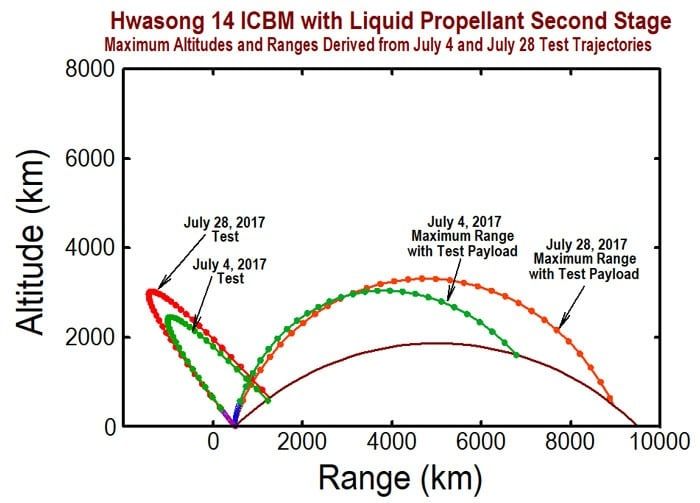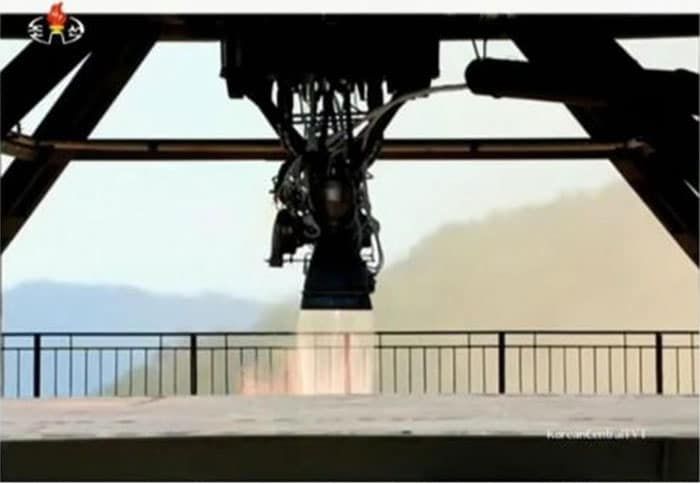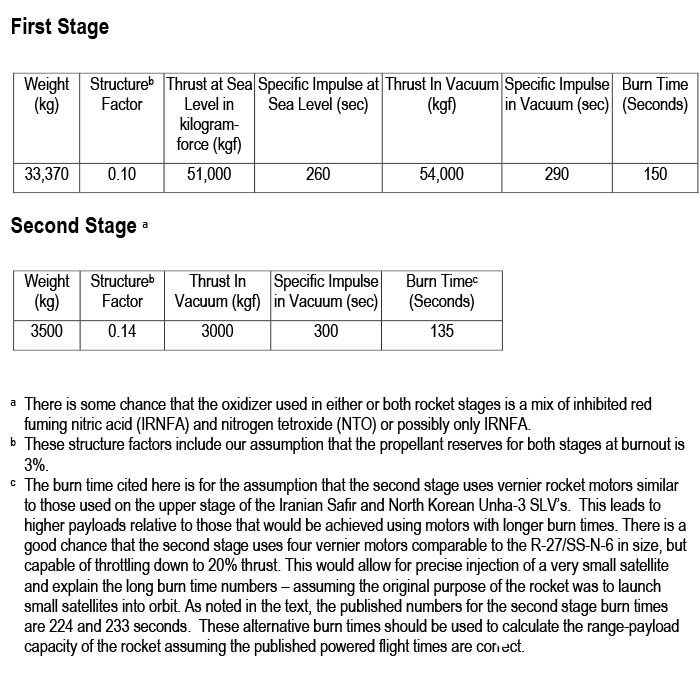On July 3, 2017, while Americans were preparing for the 241st celebration of the Declaration of Independence, a lone rocket rose from North Korea on a near-vertical trajectory. After five to six minutes of powered flight, the second stage of the missile shut down and coasted to an altitude of about 2,720 kilometers. It then fell back to Earth, reentering the atmosphere above the Sea of Japan some 900 kilometers to the east of where it had launched. The rocket’s upper stage coasted in freefall for about 32 minutes, and the overall time-of-flight, from launch to atmospheric reentry, was about 37 minutes. The launch occurred at 8:39 p.m., United States’ Eastern time. Within hours, the news of the launch was trumpeted by the US mainstream press: North Korea had flown an intercontinental ballistic missile (ICBM), a missile that could carry nuclear warheads to Anchorage, Alaska, and to the continental United States as well!
But the Western press apparently did not know one crucial fact: The rocket carried a reduced payload and, therefore, was able to reach a much higher altitude than would have been possible if it had instead carried the weight associated with the type of first-generation atomic bomb North Korea might possess. Experts quoted by the press apparently assumed that the rocket had carried a payload large enough to simulate the weight of such an atomic bomb, in the process incorrectly assigning a near-ICBM status to a rocket that was in reality far less capable.
Only three and a half weeks later, on July 28, there was a second launch of the same type of missile, this time at night, Korean time. The rocket flew approximately the same powered flight trajectory that it had on July 3 (or July 4 in North Korea), this time, however, reaching a higher altitude—a reported 3,725 kilometers. This longer flight path led to yet more unwarranted conclusions that the continental United States was now directly under threat of nuclear attack by North Korea. Actually, however, in this second case, by our calculations, the second stage of the so-called ICBM carried an even smaller payload and tumbled into the atmosphere at night over the Sea of Japan. The spectacular night-reentry of the rocket—what was almost certainly the heavy front-end of the nearly empty upper stage—created an impressive meteoric display that some experts mistook for the breakup of a failed warhead reentry vehicle.
From the point of view of North Korean political leadership, the general reaction to the July 4 and July 28 launches could not have been better. The world suddenly believed that the North Koreans had an ICBM that could reach the West Coast of the United States and beyond. But calculations we have made—based on detailed study of the type and size of the rocket motors used, the flight times of the stages of the rockets, the propellant likely used, and other technical factors—indicate that these rockets actually carried very small payloads that were nowhere near the weight of a nuclear warhead of the type North Korea could have, or could eventually have. These small payloads allowed the rockets to be lofted to far higher altitudes than they would have if loaded with a much-heavier warhead, creating the impression that North Korea was on the cusp of achieving ICBM capability.
In reality, the North Korean rocket fired twice last month—the Hwasong-14—is a “sub-level” ICBM that will not be able to deliver nuclear warheads to the continental United States. Our analysis shows that the current variant of the Hwasong-14 may not even be capable of delivering a first-generation nuclear warhead to Anchorage, Alaska, although such a possibility cannot be categorically ruled out. But even if North Korea is now capable of fabricating a relatively light-weight, “miniaturized” atomic bomb that can survive the extreme reentry environments of long-range rocket delivery, it will, with certainty, not be able to deliver such an atomic bomb to the lower 48 states of the United States with the rocket tested on July 3 and July 28.
First, the bottom line. In each of the two North Korean tests in July, the rockets were fired on a trajectory that sent them to high altitudes; on these trajectories, the rockets travelled relatively short horizontal distances. But after the tests, analysts projected the maximum range the rockets could have traveled by assuming that they could have been placed on trajectories that would result in a maximum achievable range, rather than a maximum achievable altitude. For example, the 2,720-kilometer altitude achieved by the July 3 rocket was determined by its burnout speed. If it is assumed that the rocket could achieve roughly the same burnout speed on a trajectory that is shaped for maximum range, it would be sufficient to carry the payload to Anchorage, Alaska.
In the case of the July 28 test, the same rocket achieved a higher burnout speed and a higher altitude—about 3,725 kilometers. If it were again assumed that the rocket’s trajectory is shaped for maximum range instead of maximum altitude, the new higher burnout speed would be able to carry the payload to Seattle, Washington.
Figure 1 below shows the trajectories flown on July 4 and July 28 that were misinterpreted as tests of a North Korean rocket capable of delivering atomic bombs to the continental United States.
Figure 1. The highly lofted rocket trajectories for the burnout speeds achieved in the July 4 and the July 28 tests are shown on the left side of the figure. The center and right side of the figure show alternative rocket trajectories that could instead have been flown with loft angles optimized for maximum range instead of for maximum altitude.
One question is not answered by this basic kinematic study of the July 4 and July 28 tests: How did the rocket achieve its burnout speed? That’s to say, what kind of rocket motors did it need to achieve the resulting burnout speed, what was the rocket’s launch weight, and most, important, what was the payload-weight carried by the rocket?
Figure 2 shows a summary of our estimates of the range versus the weight of atomic bomb that might be carried by a Hwasong-14 missile, derived from our technical analysis of the Hwasong-14’s weight and propulsive capabilities and the likely weight of a North Korean nuclear warhead.
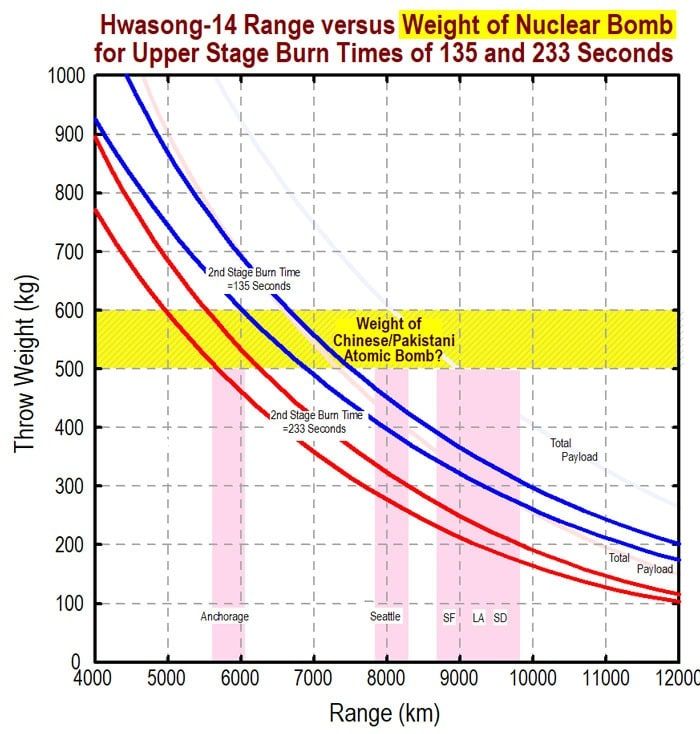
Figure 2.
The analysis results summarized in the graph are for two different “designs” of the Hwasong-14.
The first design uses published information about the powered flight time of the second stages of the rockets and is reflected by the red curves in Figure 2. Those two curves correspond to reported second-stage flight times of 224 and 233 seconds for the two rocket tests. We have received two independent confirmations of these published flight times from sources that we believe to be reliable. As those curves show, if the North Koreans have achieved the capability of creating a missile warhead as light-weight as those used by the Chinese and Pakistani militaries—no small feat for a country with means as limited as North Korea’s—the two missiles fired in July could carry that missile roughly 6,000 kilometers, approximately the distance to Anchorage, Alaska. The missiles simply could not carry such a warhead to the lower 48 states.
The second design—reflected by the blue curves in Figure 2—assumes that the North Koreans actually use more efficient rocket motors than are indicated by the information published in major media about the powered flight trajectory of the second upper stage. In this second design, we assumed that the rocket’s upper stage would be powered by rocket motors similar to those with characteristics demonstrated in the top stages of the North Korean Unha-3 and the Iranian Safir Satellite Launch Vehicle (SLV). We believe North Korea is capable of building such a variant of the Hwasong-14, and that variant could have the capability to deliver a first-generation weaponized North Korean atomic bomb to Anchorage, Alaska, and slightly beyond.
But neither variant of the Hwasong-14 we have studied could carry a first-generation weaponized North Korean atomic bomb to any part of the continental United States beyond Alaska.
Atomic bomb weights—without the hype. At this time, no one outside of North Korea has solid information about the characteristics of North Korea’s nuclear weapons designs—especially about whether or not the weapons that have been tested are cumbersome laboratory devices or readily militarized designs that could be put into bombs or carried on ballistic missiles. This information is simply not available at this time.
We are therefore left to speculate based on intelligence information that we have from other sources and on an understanding of the very significant technical problems of design and implementation that must be solved to be able to build and deliver atomic bombs by ICBM.
There is general information about an atomic bomb design that was obtained by Pakistan from China, and by Libya from Pakistan. A.Q. Khan, a Pakistani known to have trafficked equipment and information that would facilitate the building of atomic bombs, is reported to have sold that design to Libya. Khan is known to have sold uranium enrichment gas-centrifuge technology to North Korea; it is very likely he also shared atomic bomb design information similar to what he sold Libya.
It is reported that the bomb design Khan sold to Libya and possibly to North Korea would produce a warhead that weighed about 500 kilograms and yielded about 10 kilotons, if properly implemented. All of the original design information from China was for devices that were aimed at assembling uranium 235 cores. This information could have been modified and used by North Korea to implement similar implosion devices to instead assemble plutonium 239 cores. However, these devices would have had to be developed and modified from the original designs.
This information is consistent with the seismic data from Pakistan’s nuclear tests in 1998, which suggest that the yield of atomic bombs tested by Pakistan is between 10 and 15 kilotons. It is also consistent with the seismic data from North Korea’s nuclear tests, which indicate maximum explosive yields of perhaps 10 to 20 kilotons.
North Korea has publicly displayed what it claims to be a standardized atomic bomb that dimensional analysis indicates could weigh as little as 400 kilograms. The device displayed by North Korea is clearly a spherical implosion design—seemingly based on the same design concept that Khan sold to Libya and used by Pakistan. (If North Korea had instead sought to impress the outside world by displaying an atomic bomb that was shaped somewhat like an egg, it could have indicated an entirely different and far more advanced design.) But the payload of a missile consists of more than a warhead. Because of the extreme environments created by long-range missile reentry to the atmosphere—including temperatures in the thousands of degrees and high deceleration forces—we have assumed that 25 percent of the payload-weight of these North Korean rockets would have to be given over to a heat shield and the structure needed to hold an atomic bomb in place during deceleration. This is an intentional underestimate of the weight of the warhead assembly, to make our assessment of the Hwasong-14’s capabilities as favorable to North Korean capabilities as possible.
In this extremely conservative estimate, and as a result of a review of the very sketchy information about nuclear weapons design information that has leaked from China to Pakistan and beyond, we think that a reasonable guess for the minimum weight of an advanced first-generation weaponized North Korean atomic bomb that is able to survive the extreme environments associated with ICBM delivery could be as low as 500 to 600 kilograms.
In our view, the engineering challenges of implementing a nuclear weapon are substantial and highly dependent on material resources, national experience, and the skill and depth of knowledge of scientists, engineers, and technicians involved at every level of the enterprise. As such, it cannot be ruled out that a North Korean weaponized device could weigh considerably more than 600 kilograms or less than 500 kilograms, but we believe it is overwhelmingly likely that it would not weigh less than 500.
Our estimates show that the Hwasong-14, using the publicly reported burn times for the upper rocket stage, could deliver a nuclear warhead only as far as Anchorage, Alaska if the warhead weighed 500 kilograms to 550 kilograms. To reach Seattle, the warhead would have to be substantially smaller, weighing no more than 300 kilos. We believe that an advanced North Korean weaponized atomic bomb would be unlikely to weigh less than 500 to 600 kilograms. So it is entirely possible that this variant of the Hwasong-14 will not be able to deliver an atomic bomb to Anchorage, Alaska.
If the upper stage of the Hwasong-14 were instead fitted with the more capable vernier motors from the SS-N-6 submarine launched ballistic missile (known in Russia as the R-27), it could potentially deliver an atomic bomb to Anchorage, if the bomb weighed less than between 650 and 750 kg. The same upgraded variant of the Hwasong-14 could only deliver an atomic bomb to Seattle if the bomb weighed less than between 400 and 450 kg.
Since it is extremely unlikely that a first-generation weaponized North Korean atomic bomb would weigh substantially less than 500 kilograms, we conclude that neither variant of the Hwasong-14 missile could deliver a first-generation North Korean atomic bomb to the continental United States.
We emphasize at this point that advances in rocketry demonstrated by North Korea in the Hwasong-14 are significant, and although the Hwasong-14 is not an immediate threat to the continental United States, variants that are almost certainly now under development, but probably years away from completion, will eventually become missiles with sufficient payloads to deliver atomic bombs to the continental United States.
Performance assessment of the Hwasong-14. Like any missile system, the actual lifting and range capability of the Hwasong-14 depends on many technical details. Among these are the type of fuel burned by the missile, the efficiency of its rocket motors, the total amount of propellant carried in each stage, the weight of the missile’s airframe, and the weight of different components, including rocket motors, plumbing, guidance and control systems, and the like.
In the case of the Hwasong-14, almost all of the critical parameters that ultimately determine the rocket’s ability to carry a payload-weight to a given range can be deduced from photographs, videos of its initial powered flight, engineering knowledge of rocket systems, and specific other engineering information that can be determined by other observations of the missile and its motor components.
For example, the performance characteristics of the main rocket motor that powers the first stage are well known. This is in part because the rocket motor has been unambiguously identified as derived from components of a well-known family of Russian rocket motors. The type of propellant used by this family of motors is also known—unsymmetrical dimethylhydrazine (UDMH) and nitrogen tetroxide (NTO), a highly energetic propellant combination used extensively in Russian rocket systems.
The dimensions of the Hwasong-14 are readily determined from photographs of the missile and its length, as measured relative to the known length of the Chinese-made vehicle that carries it. Since the density of the propellant is known, and the dimensions of the rocket stages and the functions of the different sections of the rocket stages are easily identified, very good estimates of the weights of the stages, airframes and rocket motors can be deduced from simple volumetric analysis and knowledge of design features. Although many of the refined details of the rocket may not be known, the general information of the type described above provides quite good estimates of how well the rocket will perform.
These data lead to an overall weight estimate of roughly 37 metric tons for the Hwasong-14. The known characteristics of the main first-stage rocket motor, and the observed rate of acceleration of the rocket at launch, result in a highly constrained check on the missile model we created to estimate its overall range and payload performance.
One critical parameter of the Hwasong-14 is not yet known with certainty: the exact powered flight time of the second stage. This parameter is an important factor in determining the overall performance of the Hwasong-14, due to a phenomenon known among rocket engineers as “gravitational losses” during powered flight. To perhaps oversimplify the physics involved, the longer the rocket motor burns against the gravitational pull of the Earth, the less efficiently it accelerates its payload to a final speed. But two articles in The Diplomat magazine have included flight times for the second stages of the rockets that North Korea launched in July. Two independent sources have confirmed those times to us as accurate.
Figure 3 shows photographs extracted from North Korean videos of the launches of the Hwasong-14 missile during the morning of July 4 (in North Korea; the evening of July 3 in the United States) and during the night-launch on July 28. Careful examination shows that the first stage of the Hwasong-14 is powered by a large single rocket motor supported by 4 small “vernier” motors that are used to change the direction of the rocket during powered flight and to maintain its vertical stability during its initial lift-off and vertical acceleration. North Korea has also released videos of tests of the Hwasong-14 rocket motor (shown firing on a test stand in Figure 4).
Figure 3.
We have identified this rocket motor as a being derived from a family of Russian rocket motors known as the RD-250 or RD-251. The original motors used six thrust chambers fed by three turbo pumps to together generate roughly about 240 tons (about 530,000 pounds) of lift.
The North Koreans probably obtained this motor and many others as part of a vast shipment of rocket components to North Korea that occurred in the late 1980s and early 1990s during the simultaneous disintegration of the national economy and political system of the Soviet Union. Until recently, almost all of the liquid-propellant motors seen in North Korea’s rockets could be traced back to the Makayev Institute, a vast and highly capable organization that was responsible for the design of all types of Soviet ballistic missiles. Because of the prominent role of Makayev in Soviet ballistic missile production, this institute would have had large numbers of rocket motors in storage that were used to build various models of SCUDs and the SS-N-6 submarine-launched ballistic missile (aka R-27) used on Russian Yankee class submarines.
The newest Russian rocket motor we have identified in the North Korean arsenal, derived from the RD-250/251 and used in the Hwasong-14, is not from the Makayev Institute, but from an entirely different major rocket motor manufacturer, NPO Energomash, which supported the OKB-456 Design Bureau in the Soviet Union. This rocket motor was associated with rocket and space launch vehicles produced in Ukraine. The presence of RD-250/251 rocket components in a new North Korean rocket raises new and potentially ominous questions about the variety and extent to which Soviet rocket motors might have been obtained by North Korea during the collapse of the Soviet Union.
Figure 4.
The adaptation that North Korean engineers have worked, using components from the powerful RD 250/251 rocket motor, can be appreciated by examining Figure 5. The original RD 250/251 was a rocket motor that consisted of six thrust chambers, driven by three powerful turbo pumps. This rocket engine can be seen in the image on the left in figure 5.
Each of the three turbo pumps in the original rocket engine was nested between two thrust chambers, at a height below the combustion chamber and above the gas exhaust nozzle of each thrust chamber. This clever design made it possible to shorten the length of the rocket motor compartment and to reduce the overall length of the first stage of a rocket.
The image on the right in figure 5 is an enlargement taken from Figure 4, a photo of the Hwasong-14 rocket motor firing on a test stand. The outline of the motor’s thrust chamber is shown in a silhouette overlay and the location of the turbopump next to the single thrust chamber is shown to be exactly at the height of the turbopump in the RD 250/251 motor complex. It is clear that the final rocket motor mounted in the Hwasong-14 has this single powerful turbopump feeding propellant to both the main rocket motor and the four smaller vernier motors used to control the direction of the missile.
The design indicates a well-thought-out approach to a completely new missile that was not seen in public until the launch of the Hwasong-12, which was essentially a test aimed at proving the functionality of the first stage of the two-stage Hwasong-14. It is a remarkable achievement in itself that North Korea has been able to master the use of these components well enough to be able to adapt them to their special purposes.
We have determined that the approximate properties of the Hwasong-14 missile, with a second stage upgraded with more capable vernier motors from the Russian R-27 missile, will be as follows:
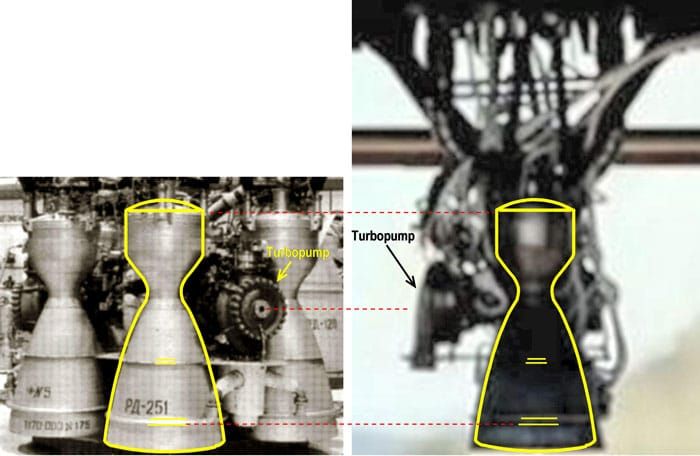
Figure 5.
General conclusions—for now. Our general conclusions from intensive study of a wide variety of data relating to the two rockets that North Korea launched in July:
- The Hwasong-14 does not currently constitute a nuclear threat to the lower 48 states of the United States.
- The flight tests on July 4 and 28 were a carefully choreographed deception by North Korea to create a false impression that the Hwasong-14 is a near-ICBM that poses a nuclear threat to the continental US.
- The Hwasong-14 tested on July 4 and 28 may not even be able to deliver a North Korean atomic bomb to Anchorage, Alaska.
- Although it is clear that North Korea is not capable of manufacturing sophisticated rocket components, their skill and ingenuity in using Soviet rocket motor components has grown very substantially. This is not good news for the long run.
It is time for the United States to get serious about diplomacy and appropriate defensive preparations (see sidebar, “Comments on the developing situation with North Korea”) to constructively support those diplomatic efforts.
